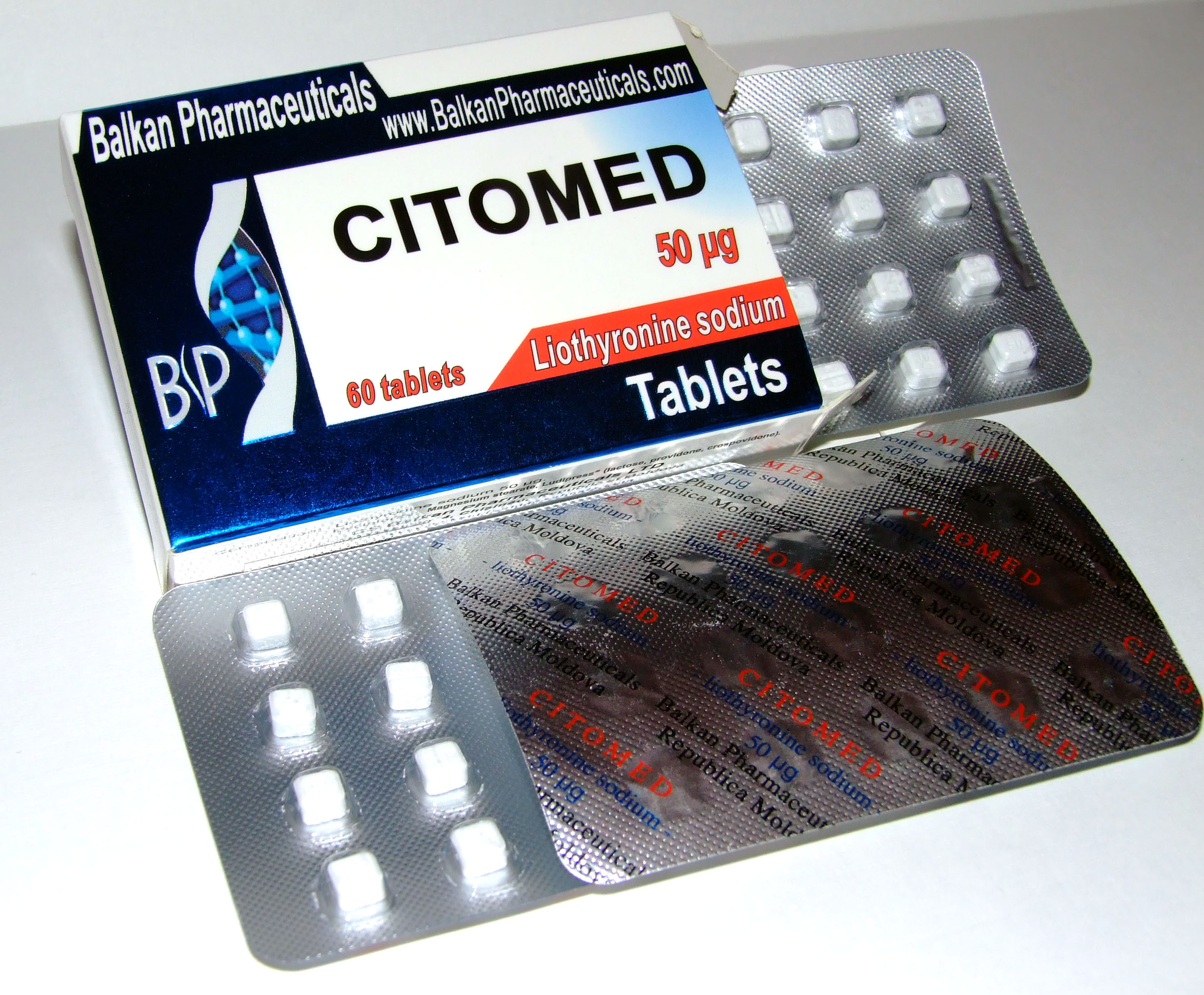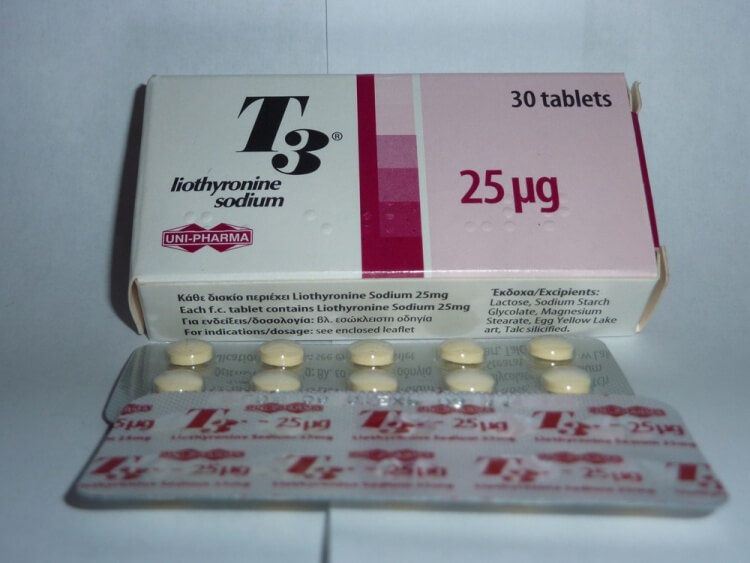
T3 (triiodothyronine, liothyronine, Cytomel) is a thyroid hormone drug fairly commonly used for fat loss, particularly in the context of anabolic steroid cycles. T3 is naturally produced in the body as a result of T4 (thyroxine) production by the thyroid. Oral administration of T3 can yield higher levels of serum T3 than would occur naturally, allowing faster fat loss and in some cases potentially greater GH production and greater anabolism.
The problem of instability of T3
The first thing to consider about dosing of T3 is that the drug itself has poor stability, resulting in loss of potency with time even with some tabletted pharmaceutical products. Liquid preparations are even more prone to loss of potency. Dosings given below refer to fully potent T3, as found with US-made or European pharmaceutical products still within expiration date. In many instances, other T3 products will contain less or even much less T3 than the label may indicate.
For this reason, I recommend seeking out genuine pharmaceutical T3, preferably of American or European origin. Otherwise, dosing can be uncertain or deceptive. For example, a person might find “150 mcg” per day to be an appropriate dose for him when using a low-potency product, but an extreme overdose when using a full-potency product.
Dosages of T3
There are two approaches to dosing T3 that I recommend.
In the first approach, the goal is to achieve an ongoing edge in fat loss or to help maintain a near-personally-ideal body composition. In this approach, T3 dosing is very low, preferably 12.5 mcg/day but in some cases as much as 25 mcg/day. At the lower end of this range, typically thyroid testing will show no detectable suppression even with prolonged use. At the higher end, moderate suppression is sometimes seen, but results are superior to when T3 is not taken, and the suppression reverses rapidly upon discontinuing T3 use.
In the second approach, the goal is to achieve a quite substantial increase in rate of fat loss, at the known cost of inducing thyroid suppression. Most preferably the dosage is about 50 mcg/day, but in some instances can be as high as 75 mcg/day. Such use is preferably not ongoing, but only for a limited period of time such as 8-12 weeks, though there’s no exact requirement for timeframe.
Dividing dose of T3
Because T3 has a short half-life, divided doses are preferable to a single dose, except where total daily dosing is small. For example, with a dosing of 12.5 mcg.day this would best be taken as a single dose in the morning, but with 50 mcg/day, dividing the daily amount into three or four doses would be better than taking the entire amount at one time.
Post-cycle suppression of natural thyroid production
After extended use of T3 at a suppressive dose, natural production is suppressed for some time after discontinuing T3 use. Generally the duration appears related to the length of use. In cases of brief usage there’s typically no noticeable period of low function post-cycle, but with extended cycles the duration of low function can be measured for as long as about six weeks in some cases.
The literature article “Recovery of pituitary thyrotropic function after withdrawal of prolonged thyroid-suppression therapy” provides an example of difficulty that can be encountered in recovering good thyroid production after a long period of oral thyroid use.
While in this study all the subjects did recover “normal” thyroid production, as also happens routinely in bodybuilding use, the “normal” that they ended up with was the rock-bottom end of the normal range, about 40 mcg/dL total serum T4 and about 80 ng/dL total serum T3. These are not levels one wants to be at, and are low enough that metabolism would be impaired.
Effects of excessive dosage of T3
High dosage of T3, typically starting at about 75 mcg/day but in some cases not starting until about 100 mcg/day, can cause tachycardia (elevated heart rate) and muscle weakness, and can be catabolic or at the least reduce anabolism. High dose anabolic steroids, of course, tend to mask this latter effect.
Very high levels of T3 are dangerous to the heart.
Interaction of high serum T3 with IGF-1
High levels of T3 reduce levels of IGF-1, which can reduce anabolic effectiveness of GH, but does not change fat-loss effectiveness of GH.
This effect causes some to view T3 as relieving side effects of GH; actually, what is occurring is the T3 is making the same dose of GH produce less IGF-1 in the body than usual. It would be more efficient simply to reduce dose of GH to a personally-suitable level.
The effect of blunting GH effectiveness is particularly pronounced when T3 dosage is greater than 50 mcg/day, and seems unnoticeable if present at all at dosings such as 25 mcg/day.
Summary
T3 is a very effective compound for aiding fat loss, but has serious side effects when overdosed. With proper care, it’s an easily-cycled compound. Because T3 has limited stability, it’s best sourced from quality pharmaceutical products, with a second choice being Third World generics or relatively-fresh powder which has been carefully measured. Liquid products can lose potency rapidly and therefore are not preferred.

About the author
Bill Roberts is an internationally-recognized expert on anabolic steroids and performance-enhancing drugs (PEDs). He received a bachelor degree in Microbiology and Cell Science and completed the educational and research requirements for a PhD in Medicinal Chemistry at a major American university.
Bill entered the nutritional supplement industry prior to completing his doctoral thesis but his education was invaluable so far as being able to design/improve nutritional supplement compounds, since it was in the field of designing drug molecules and secondarily some work in transdermal delivery.
His education was not specifically "geared" toward anabolic steroids other than expertise with pharmacological principles having broad applications. This has allowed Bill to provide unique insight into the field of anabolic pharmacology with knowledge of points which he would not have known otherwise.